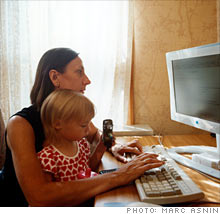Press restart on your career
Getting back into the job market after time off is harder than ever. These four strategies can help.
 |
| Li Graham, 49, stay-at-home mom, Silver Spring, Md. |
 |
| Once Li is eligible to contribute to an employee retirement account, she should coordinate her asset allocation with husband Steve to make sure they aren't being too risky or conservative. |
(Money Magazine) -- Li Graham is plenty busy. As a mother of 6-year-old triplets and a 2-year-old, her hands - let alone her mini-van, laundry basket, and grocery cart - are more than full. Yet Graham, 49, who has spent the past six years at home after 18 years working in the business side of the publishing industry, craves the satisfaction she felt as a professional - not to mention the financial benefits.
When the market tanked, she and her husband, Steve, 50, an executive at an aerospace company, lost about 40% of their retirement savings. Moreover, Steve's company cut its 401(k) match, and while his employment seems stable, the Grahams are well aware that no job today is totally safe. "I'm concerned that I'm not contributing enough," says Li.
Plenty of mothers share Li's sentiment. In a recent survey by MyWorkButterfly.com, a website for moms returning to the workforce, 71% of mothers who went back to work named financial security as the most important benefit.
But these days many stay-at-home moms, like retirees and others who have been off the full-time track for a while, are finding that nabbing a job is no easy matter. Not only are they facing the most sour job market in decades, but they're also competing with scores of candidates who don't have a rusty skill set and a gap in their résumé to explain.
The following strategies should help Li - and anyone else embarking on a post-hiatus job hunt - get a foot back in the door.
Two major factors should dictate your approach to the job search: the kind of job you want, and the financial benefits you hope to gain.
Many returning moms go through a "floundering" period when trying to figure out what kind of job to go after, says Carol Fishman Cohen, co-founder of career reentry site iRelaunch.com. Li, for example, has no less than four ideas for a small business, and she's thinking about returning to publishing or shifting into a career with a more flexible schedule - say, in education.
To narrow down the possibilities, think about the hours you're willing to work and the schedule that various jobs would require. And take into account where you have the best shot at getting an offer. Right now government, health care, and education are the areas most likely to be hiring, says Terry Nagel, head of Encore.org, a resource for people seeking second careers. In Li's industry some web publications have weathered the downturn better than their print counterparts.
Next consider your financial goals. If extra income is your most pressing need, figure out the minimum you'll have to make after accounting for new expenses like child care, transportation, office lunches, and dry cleaning.
But salary isn't the whole story. You should add in the value of key benefits such as life insurance and a health insurance plan that might be cheaper than the one you currently use. If, like the Grahams, you have a pressing need to get your retirement savings back on track, you'll want to target companies that offer a 401(k) match and perhaps even a pension as well, says financial adviser Amy Barrett.
One thing moms reentering the workforce can be sure of: How you did your job before you took time off has probably changed dramatically. To find out what you need to learn or brush up on, Fishman Cohen suggests taking former colleagues out to lunch and asking what specific new skills are crucial to the job. "Ask questions like 'Remember how we used to use that special spreadsheet to figure out costs? How do you do it now?'" she says.
Li will probably discover that online work is a much greater part of the job than it was when she left. To refresh skills in that area, she may want to sign up for a workshop from an industry group or take a course at a local college.
Recession or no, most people still find jobs through personal contacts. So priority No. 1 is reconnecting with as many of those former colleagues as you can. That includes not only people who were on your level, but also those who were junior to you - since you've been out of the workforce, they may have moved up and may even be in a position to hire.
Li can use a professional networking site like LinkedIn to expand her connections by reaching out to new people who currently work for her former employers. She can also enhance her online profile by garnering recommendations from former colleagues or people she may have volunteered with during her years at home.
No matter how good your contacts, you're still going to have to find a way to cut in front of hundreds of other qualified applicants. Tap your newly re-formed network to see whether anyone is looking for help with a freelance or consulting project; with all the turmoil and layoffs going on, employers are having trouble getting some short-term projects finished. Once the boss is familiar with your work, he or she will be more likely to consider you for a staff position.
Or find a relevant volunteer project: Even if it doesn't get you a job, it will give you something current to put on your résumé.
One plus for an overburdened mom: If you're looking for flexibility, you may find that works to your advantage. Says Allison O'Kelly, founder of Mom Corps, a staffing company dedicated to helping women reenter the workforce: "Offering to work on a part-time or trial basis may be very attractive to an employer who needs to cut costs." Finally, be realistic: To get hired, you may need to take a lateral or lower position than you had before.
All that makes sense to Li, who has recently gone on a handful of interviews for publishing jobs. "I'm not sure how it will all work out," she says, "but I'm ready to take on both roles now."
Li and Steve Graham need to get their retirement savings back on track. First step: Put away more.
1. Fund an IRA, ASAP. The Grahams shouldn't wait to start funding their retirement accounts. Li, who turns 50 in November, and Steve can each contribute $6,000 to Roth IRAs this year. In addition, Li should fully fund her employee retirement plan once she becomes eligible later on.
2. Make the most of her résumé. There's no point in trying to hide a career gap. Li may want to list her time at home in a category called "personal," below her professional experience. She should, however, be sure to mention any volunteer or freelance work that relates to her career goals.
3. Seek out a staff position. Li is drawn to the flexibility of self-employment, but she may be underestimating how costly and time-consuming a small business can be, says Leslie Godwin, a career coach who specializes in moms returning to work. A corporate job also holds the possibility of a 401(k) with an employer match, which will let the Grahams rebuild their savings faster. ![]()


